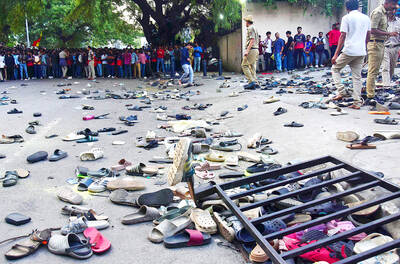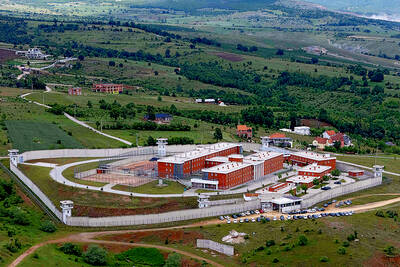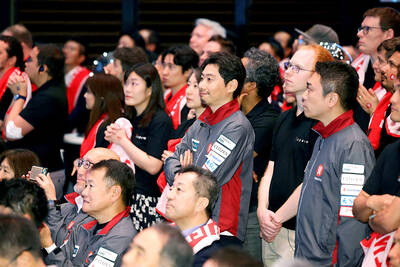Japan manages a rare feat for a developed nation when it comes to feeding its children — high scores for nutrition, but very low obesity rates.
One major key? School lunches.
A landmark report by UNICEF yesterday showed that Japan tops the charts for childhood health indicators, with low rates of infant mortality and few underweight children, but it also manages the lowest incidence of childhood obesity among the 41 developed nations in the Organisation for Economic Co-operation and Development and the EU.
Experts say there are various factors at work, including a health-conscious society and regularly mandated health checkups for children, but a nationwide school lunch program also plays a key role.
“School lunches with menus that are created by nutritionists are provided to all primary schools and the majority of junior high schools throughout Japan,” Tokyo Kasei Gakuin University professor and pediatrician Mitsuhiko Hara said.
The lunches are mandatory — no packed lunches are allowed — and while they are not free for most, they are heavily subsidized.
Each meal is designed to have about 600 to 700 calories balanced between carbohydrates, meat or fish and vegetables.
One sample meal served to children in Japan’s Gunma gives a flavor: rice with grilled fish, and a spinach and sprout dish, served with miso soup with pork, alongside milk and dry prunes.
“School lunch is designed to provide nutrition that tends to be lacking in meals at home,” Japanese Ministry of Education, Culture, Sports, Science and Technology official Mayumi Ueda said. “I think it contributes to the nutritional balance necessary for children.”
The lunches are conceived not only to feed children, but to teach them.
“There’s also a daily broadcast at school to explain the nutritional elements contained in the school lunch of the day, and this is a good way to educate kids,” Hara said.
Students use magnets with pictures of food and place them into different categories on a whiteboard, learning to tell their proteins from their carbohydrates.
“School lunch is positioned as part of education under the law,” Ueda said. “It’s not just about eating food, but children learn to serve and clean up on their own.”
The Japanese government studies nutrition and eating habits annually, and uses the results to shape what goes into the school meals, she added.
School lunches in Japan date back to as early as 1889, when rice balls and grilled fish were provided for children living in poverty in northern Yamagata Prefecture. The program was expanded nationwide after World War II ended to address childhood hunger amid serious food shortages.
There are also other factors at work, Hara said.
“Because many Japanese are health-conscious, they try to eat a variety of food, which is good, and we’re taught to eat seasonal food, which also contributes to good health,” he said. “Japan is one of the rare countries that pay so much attention to food that is associated with specific seasons.”
The results are clear in the statistics: Japan has one of the world’s lowest rates of infant mortality and the rate of children aged five to 19 who are overweight or obese is 14.42 percent, far lower than most other developed nations.
Another factor in Japan is regularly mandated childcare health checks, Hara said.
Parents of infants receive reminders from the local government and children are given health checks at school.
Despite this, even Japan has not escaped entirely the growing trend toward overweight children and childhood obesity, which tends to affect those from less wealthy families.
“Children in poverty are more likely to be overweight because families try to cut costs,” Hara said. “As a result, they eat less protein, but consume more carbs and sugar, which leads to obesity.”
School lunches are all the more important to children in such situations, he said.
“A lot of nutrition is supplemented by school lunches ... so it also serves as a meal that saves children in poverty,” he added.

Packed crowds in India celebrating their cricket team’s victory ended in a deadly stampede on Wednesday, with 11 mainly young fans crushed to death, the local state’s chief minister said. Joyous cricket fans had come out to celebrate and welcome home their heroes, Royal Challengers Bengaluru, after they beat Punjab Kings in a roller-coaster Indian Premier League (IPL) cricket final on Tuesday night. However, the euphoria of the vast crowds in the southern tech city of Bengaluru ended in disaster, with Indian Prime Minister Narendra calling it “absolutely heartrending.” Karnataka Chief Minister Siddaramaiah said most of the deceased are young, with 11 dead

By 2027, Denmark would relocate its foreign convicts to a prison in Kosovo under a 200-million-euro (US$228.6 million) agreement that has raised concerns among non-governmental organizations (NGOs) and residents, but which could serve as a model for the rest of the EU. The agreement, reached in 2022 and ratified by Kosovar lawmakers last year, provides for the reception of up to 300 foreign prisoners sentenced in Denmark. They must not have been convicted of terrorism or war crimes, or have a mental condition or terminal disease. Once their sentence is completed in Kosovan, they would be deported to their home country. In

Brazil, the world’s largest Roman Catholic country, saw its Catholic population decline further in 2022, while evangelical Christians and those with no religion continued to rise, census data released on Friday by the Brazilian Institute of Geography and Statistics (IBGE) showed. The census indicated that Brazil had 100.2 million Roman Catholics in 2022, accounting for 56.7 percent of the population, down from 65.1 percent or 105.4 million recorded in the 2010 census. Meanwhile, the share of evangelical Christians rose to 26.9 percent last year, up from 21.6 percent in 2010, adding 12 million followers to reach 47.4 million — the highest figure

LOST CONTACT: The mission carried payloads from Japan, the US and Taiwan’s National Central University, including a deep space radiation probe, ispace said Japanese company ispace said its uncrewed moon lander likely crashed onto the moon’s surface during its lunar touchdown attempt yesterday, marking another failure two years after its unsuccessful inaugural mission. Tokyo-based ispace had hoped to join US firms Intuitive Machines and Firefly Aerospace as companies that have accomplished commercial landings amid a global race for the moon, which includes state-run missions from China and India. A successful mission would have made ispace the first company outside the US to achieve a moon landing. Resilience, ispace’s second lunar lander, could not decelerate fast enough as it approached the moon, and the company has